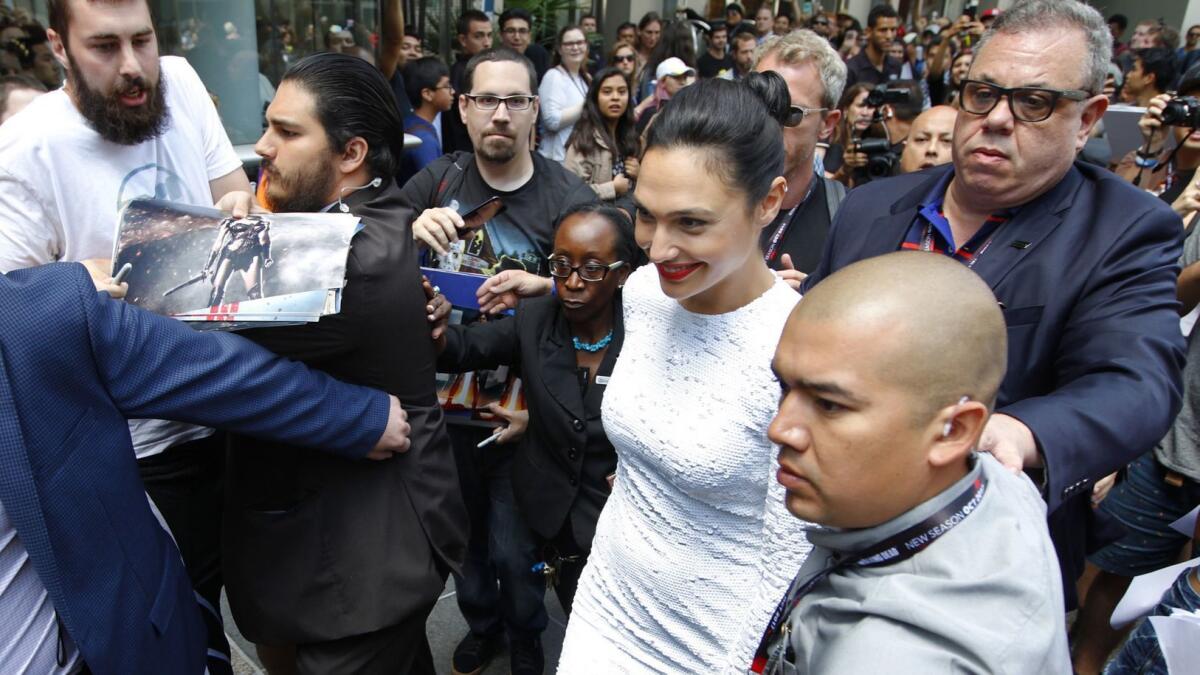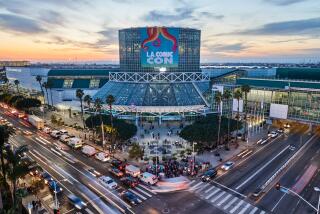Comic-Con Confidential: How to throw a $16 million pop culture blowout

Comic-Con is the Rubik’s Cube of conventions. By Wednesday evening, Preview Night, every piece of this pop culture puzzle will have been snapped into place.
After a year of juggling countless moving parts.
“The show gets exponentially more difficult each year,” said Mark Evanier, a
FULL COVERAGE: Comic-Con 2018 »
comic book and TV writer who has been a Comic-Con regular since its 1970 debut. “They have figured out how to do that convention in that building so well, they make it look easy.”
Easy? Sure, and Bruce Wayne is merely a millionaire playboy.
From the first panel presentation (“Teaching with Comics,” 4 p.m. Wednesday at the Central Library) to the last anime screening (“Fairy Tail Zero” and three other shorts, 4:45 p.m. Sunday in the Marriott Hotel), 2,000 hours of talks, films, masquerades, video games and art exhibits will unspool in the San Diego Convention Center and surrounding venues.
“Things can take anywhere from a few years of planning up to a few weeks,” said David Glanzer, Comic-Con’s director of communications. “Comic-Con is like a big aircraft carrier. It has a lot of momentum, but we always want to make sure we are headed in the right direction.”
This year’s behemoth is nearing its destination. How did it get here?
Rolling your own
Like Superman and Wonder Woman, Comic-Con’s origin is shrouded in legend. The annual event now requires 4,500 volunteers, but it began as a modest gathering planned by a handful of comic book, science fiction and movie fans, most of them teens.
And while Comic-Con’s expenses this year are estimated at around $16 million, the inaugural event was funded with pocket change. One of the kids, the late Richard Alf, raided his savings from a part-time job.
“He set aside $3,000 to cover any expenses,” said Mike Towry, who, like Alf, was in high school when the convention debuted in 1970.
Officially led by two adults — Ken Krueger, owner of an Ocean Beach comics shop, and Shel Dorf, a recent transplant from Michigan who had organized similar conventions in Detroit — the first Comic-Con blended ambition and amateurism. To invite a prospective headliner, Captain America co-creator Jack Kirby, the teens pooled their money to rent a car for the trip to the writer’s Irvine home. Another prevailed upon his mother to drive him there.
Charmed by these enthusiastic young fans, Kirby accepted. So did science fiction writer Ray Bradbury, who was cornered after a talk at UC San Diego. For the remainder of their lives — Kirby died in 1994 Bradbury in 2012 — both were Comic-Con regulars.
This year, Comic-Con will draw 135,000 ticket holders. Roughly 200,000 others will flood the Gaslamp Quarter for the festivities occurring outside the convention center: walk-through installations, movie premieres, TV pilots, video game competitions.
In that mob, about a half dozen will be able to claim attendance at every Comic-Con. Among that select few will be Evanier, a comic book writer, cartoon show veteran and Kirby biographer who will moderate 13 panels this year.
Evanier has seen the show morph from its humble beginnings into a world-famous entertainment juggernaut. Case in point: For the fourth straight year, Conan O’Brien’s late night show will be broadcast from the Spreckels Theatre. His guest list is drawn from celebrities appearing at the convention: Samuel L. Jackson, Olivia Munn, Bryan Cranston and others.
Still, Evanier rejects the notion that Comic-Con has been captured by the movies or TV. That’s a common lament — or boast, as Evanier heard last year from a representative of “Team Coco.”
“Don’t you think that Conan has become the signature person at Comic-Con?” the publicist asked, noting that even San Diego’s trolleys were wrapped with billboard-sized ads for TBS’ “Conan” show. “It’s all about him.”
“No,” Evanier shot back, “it’s not about anyone.”
The show is too multi-faceted, he explained, for any single person, medium or genre to dominate.
“Ninety-nine percent of the people who come to Comic-Con don’t care that Conan is there. It’s all about the event, not about any one person,” he said. “Everyone has a very different Comic-Con. You have to roll your own.”
And roll with the pop culture punches.
Chris Hardwick, founder of Nerdist, lost his Comic-Con moderating gig last month when allegations surfaced he had sexually assaulted an ex-girlfriend, Chloe Dykstra. Yet the panels he had been expected to lead, on BBC America’s “Doctor Who” and AMC’s “The Walking Dead,” are still scheduled and still feature a full complement of cast and crew members.
Likewise, Glanzer shrugged off news that Marvel Studios and HBO’s popular “Game of Thrones” and “Westworld” are not attending this year’s Comic-Con. Studios have skipped the show before, he noted, only to return.
“A studio that feels they don’t have something that aligns with our fans will sit out of a year,” he said. “And I appreciate that.”
Evanier argues that the show will continue to draw top talent, even though there is increasing competition from comic book conventions in New York City, Chicago and elsewhere.
“The San Diego Con has an advantage in that it sells out in 42 minutes,” he said. “They have no problem packing the room.”
Those SRO rooms — especially Hall H, the convention center’s largest venue — provide instant feedback to Hollywood executives eager to build buzz for upcoming movies and TV shows.
In San Diego, said Heidi MacDonald, editor of the comics blog The Beat, “you’re going to find out if you’re Hall H-worthy.”
Rock stars
San Diego Comic-Con International, the official name of the host organization, is a shadowy group. All inquiries are directed to Glanzer, the communications director. Volunteers approached for this story declined to be interviewed, insisting that all comments come from Glanzer.
A single voice, then, represents the convention to the public.
(One annual exception to this rule: on Sunday afternoon, the otherwise reclusive board president John Rogers fields questions — and complaints — from Con-goers.)
The Beat’s MacDonald doesn’t blame Comic-Con for this Pentagon-like control on its message.
“They are under so much scrutiny, people will exploit any vulnerabilities,” she said. “Security is a huge part of it, especially now.”
The show’s under-the-radar approach, though, fuels plenty of misperceptions. “People think this organization is really huge,” Glanzer said. “There are really huge parts to it, but it’s really a small group of people.”
Certainly, the job is large. Besides Comic-Con, the organization runs WonderCon, a similar convention held each March in Anaheim.
The board of directors, though, numbers a lean 13; there are about 80 fulltime staffers, including temps. Much of the year-round work is entrusted to committee of about 200 volunteers that meets eight times year.
Roughly 900 people serve on subcommittees that coordinate each aspect of the show, from special guests to programming, from the Eisner awards — the comic industry’s equivalent of the Oscars — to the annual masquerade, traditionally Saturday night’s highlight.
Blocs of hotel rooms are reserved a year or more in advance. Invitations to honored guests, many of whom are offered airfare and lodging, are issued months in advance.
“To us,” Glanzer said, “they’re the rock stars.”
Even so, many of these stars lack intergalactic renown. At Friday night’s Eisners, for instance, Evanier will present the Bill Finger Award for Excellence in Comic Book Writing to Joye Murchison Kelly.
Who?
“She’s the most obscure person in the history of the comic book industry,” Evanier said. “But in the 1940s, she was the ghost writer for ‘Wonder Woman.’”
From 1944 through 1947, Kelly wrote under the name “William Marston,” the superheroine’s dying creator. Her contributions were uncredited and largely unknown. Now 94 and living in Florida, Kelly has never even attended a comics convention.
This week, DC Comics and Comic-Con will change that. DC, the current publisher of “Wonder Woman,” provided first class airfare to San Diego for Kelly and her husband. The convention is covering the cost of their room.
“It’s overwhelming,” Kelly said of the message she received from Evanier.
“When you are 94 and somebody is suddenly on the telephone telling you that you’ve got the highest award given to a comics writer, and besides you will be the first living woman to get it — I couldn’t believe what he was saying.”
Big wheel
Whisking Kelly and better-known stars like Ryan “Deadpool” Reynolds from their hotels to their Convention Center appearances is the job of Steve Weathers and his team.
Weathers, owner of San Diego-based SEAT Planners Inc., has contracted with Comic-Con for various services for more than three decades. This year, his company is charge of the mile-long lines stretching from the harbor to Hall H; erecting temporary concrete barriers between automotive and foot traffic; and running the shuttles between the center and hotels around town.
These tasks have grown with the convention. In 1991, the first year SEAT operated the shuttles, it logged about 16,000 passenger trips. This year, Weathers estimates his company will ferry more than 150,000 passengers.
“At the peak,” he said, “we’ll use 62 buses at any one time.”
Planning for this show occupies five SEAT employees for seven weeks, and this is just one of numerous outside constrators hired by Comic-Con. Meeting Services, Inc., provides audio-visual services; Freeman Decorating sets up the exhibition hall; Staff Pro supplies security; and the firm of Pillsbury Winthrop Shaw Pittman handles legal matters.
“I’m only a cog,” Weathers said. “It’s a big wheel.”
That wheel keeps turning. When this year’s convention ends on July 22, Glanzer, the paid staff and the army of volunteers will close up shop for a week. Then they’ll start planning the 2019 show, San Diego’s 50th annual Comic-Con.
This golden anniversary’s theme and headliners have yet to be determined, but Glanzer already understands the mission.
“You have to provide the kind of show our fans and attendees want,” he said. “If the show ended, we would have no one to blame but ourselves.”
More to Read
The biggest entertainment stories
Get our big stories about Hollywood, film, television, music, arts, culture and more right in your inbox as soon as they publish.
You may occasionally receive promotional content from the Los Angeles Times.











